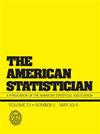研究性研究设计的统计原理本科课程
IF 2.1
4区 数学
Q1 STATISTICS & PROBABILITY
引用次数: 0
摘要
统计和数据科学的本科课程正在发生变化,以适应新的方法,新的感兴趣的学生,以及统计在社会中不断变化的角色。正因为如此,学生了解研究设计的作用以及如何制定有意义的科学和统计研究问题比以往任何时候都更加重要。虽然传统的实验设计课程对于走向工业和研究职业的学生仍然非常有价值,但更广泛的研究设计课程,包括调查抽样,观察研究和随机实验设计因果推理的基础知识,对具有广泛应用兴趣的学生特别有用。在这里,我描述了一所小型文理学院的这门课程,以及如何适应不同的学生和老师的背景和兴趣。本课程是通往高级统计课程的宝贵桥梁,满足关键的统计素养和沟通学习目标,并可根据所需的计算和数学流畅程度进行定制。通过阅读、讨论和评论实际发表的研究报告,学生们了解到统计学是一门具有实际影响的活生生的学科,并成为科学研究和数据驱动见解的更好的消费者和生产者。本文章由计算机程序翻译,如有差异,请以英文原文为准。
An Undergraduate Course on the Statistical Principles of Research Study Design
The undergraduate curriculum in statistics and data science is undergoing changes to accommodate new methods, newly interested students, and the changing role of statistics in society. Because of this, it is more important than ever that students understand the role of study design and how to formulate meaningful scientific and statistical research questions. While the traditional Design of Experiments course is still extremely valuable for students heading to industry and research careers, a broader study design course that incorporates survey sampling, observational studies, and the basics of causal inference with randomized experiment design is particularly useful for students with a wide range of applied interests. Here, I describe such a course at a small liberal arts college, along with ways to adapt it to meet different student and instructor background and interests. The course serves as a valuable bridge to advanced statistical coursework, meets key statistical literacy and communication learning goals, and can be tailored to the desired level of computational and mathematical fluency. Through reading, discussing, and critiquing actual published research studies, students learn that statistics is a living discipline with real consequences and become better consumers and producers of scientific research and data-driven insights.
求助全文
通过发布文献求助,成功后即可免费获取论文全文。
去求助
来源期刊

American Statistician
数学-统计学与概率论
CiteScore
3.50
自引率
5.60%
发文量
64
审稿时长
>12 weeks
期刊介绍:
Are you looking for general-interest articles about current national and international statistical problems and programs; interesting and fun articles of a general nature about statistics and its applications; or the teaching of statistics? Then you are looking for The American Statistician (TAS), published quarterly by the American Statistical Association. TAS contains timely articles organized into the following sections: Statistical Practice, General, Teacher''s Corner, History Corner, Interdisciplinary, Statistical Computing and Graphics, Reviews of Books and Teaching Materials, and Letters to the Editor.
 求助内容:
求助内容: 应助结果提醒方式:
应助结果提醒方式:


